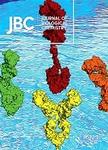版权所有:内蒙古大学图书馆 技术提供:维普资讯• 智图
内蒙古自治区呼和浩特市赛罕区大学西街235号 邮编: 010021

作者机构:SUNY Buffalo Dept Biochem Sch Med & Biomed Sci Buffalo NY 14214 USA
出 版 物:《JOURNAL OF BIOLOGICAL CHEMISTRY》 (生物化学杂志)
年 卷 期:1999年第274卷第41期
页 面:29211-29219页
核心收录:
学科分类:0710[理学-生物学] 071010[理学-生物化学与分子生物学] 07[理学]
基 金:NIGMS NIH HHS [GM46787] Funding Source: Medline
主 题:结合部位 阳离子转运蛋白质类 铜/代谢 铜/药理学 DNA结合蛋白质类/化学 DNA结合蛋白质类/遗传学 二聚作用 荧光抗体技术 真菌蛋白质类/化学 真菌蛋白质类/遗传学 膜蛋白质类/遗传学 核定位信号 核蛋白质类/化学 核蛋白质类/遗传学 点突变 启动区 遗传 蛋白质结构 二级 酿酒酵母菌/代谢 酿酒酵母蛋白质类 构效关系 反式激活因子类/化学 反式激活因子类/遗传学 转录因子/化学 转录因子/遗传学
摘 要:The Mac1 protein in Saccharomyces cerevisiae is essential for the expression of yeast high affinity copper uptake. A positive transcription factor, Mac1p binds via its N-terminal domain to GCTC elements in the promoters of CTR1 and FRE1, encoding a copper permease and metal reductase, respectively. Mac1p-dependent transcriptional. activation is negatively regulated by copper. We have mapped the domains in Mac1p responsible for its nuclear localization and for the protein-protein interactions that underlie its transcriptional activity. Immunofluorescence studies indicate that Mac1p contains two nuclear localization signals, one each in the N- and C-terminal halves of the protein. Yeast one-hybrid analysis demonstrates that the copper-dependent transcriptional activity in Mac1p resides primarily in a cysteine-rich element encompassing residues 264-279. Two-hybrid analysis indicates that a copper-independent Mac1p-Mac1p interaction linked to DNA binding is due primarily to a predicted helix in the C-terminal region of the protein encompassing residues 388-406. Point mutations within this putative helix abrogate the Mac1-Mac1 interaction in vivo and formation of a ternary (Mac1p)(2).DNA complex in vitro. When produced in normal abundance, Mac1pI396D and Mac1pF400D helix mutants do not support transcriptional activation in vivo consistent with an essential Mac1p dimerization in transcriptional activation. Lastly, the one- and two-hybrid data indicate that an intramolecular interaction between the DNA-binding and transactivation domains negatively modulates Mac1p activity.